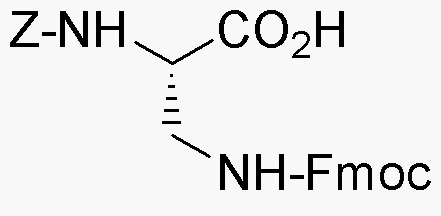Na-Z-Nb-Fmoc-L-2,3-diaminopropionic acid is widely utilized in research focused on:
- Peptide Synthesis: This compound serves as a crucial building block in the synthesis of peptides, particularly in the development of therapeutic proteins. Its unique structure allows for the incorporation of specific amino acid sequences that can enhance biological activity.
- Drug Development: In pharmaceutical research, it is used to create novel drug candidates. The ability to modify its structure helps in optimizing the pharmacokinetic properties of potential drugs.
- Bioconjugation: This chemical is valuable in bioconjugation processes, where it can be linked to other biomolecules, such as antibodies or enzymes, to create targeted drug delivery systems, improving treatment efficacy.
- Research in Neuroscience: It is applied in studies related to neuropeptides, aiding in the understanding of neurological pathways and the development of treatments for neurological disorders.
- Custom Synthesis: Researchers often utilize it for custom synthesis projects, allowing for the creation of tailored compounds that meet specific research needs, thus providing flexibility in experimental design.
General Information
Properties
Safety and Regulations
Applications
Na-Z-Nb-Fmoc-L-2,3-diaminopropionic acid is widely utilized in research focused on:
- Peptide Synthesis: This compound serves as a crucial building block in the synthesis of peptides, particularly in the development of therapeutic proteins. Its unique structure allows for the incorporation of specific amino acid sequences that can enhance biological activity.
- Drug Development: In pharmaceutical research, it is used to create novel drug candidates. The ability to modify its structure helps in optimizing the pharmacokinetic properties of potential drugs.
- Bioconjugation: This chemical is valuable in bioconjugation processes, where it can be linked to other biomolecules, such as antibodies or enzymes, to create targeted drug delivery systems, improving treatment efficacy.
- Research in Neuroscience: It is applied in studies related to neuropeptides, aiding in the understanding of neurological pathways and the development of treatments for neurological disorders.
- Custom Synthesis: Researchers often utilize it for custom synthesis projects, allowing for the creation of tailored compounds that meet specific research needs, thus providing flexibility in experimental design.
Documents
Safety Data Sheets (SDS)
The SDS provides comprehensive safety information on handling, storage, and disposal of the product.
Product Specification (PS)
The PS provides a comprehensive breakdown of the product’s properties, including chemical composition, physical state, purity, and storage requirements. It also details acceptable quality ranges and the product's intended applications.
Certificates of Analysis (COA)
Search for Certificates of Analysis (COA) by entering the products Lot Number. Lot and Batch Numbers can be found on a product’s label following the words ‘Lot’ or ‘Batch’.
*Catalog Number
*Lot Number
Certificates Of Origin (COO)
This COO confirms the country where the product was manufactured, and also details the materials and components used in it and whether it is derived from natural, synthetic, or other specific sources. This certificate may be required for customs, trade, and regulatory compliance.
*Catalog Number
*Lot Number
Safety Data Sheets (SDS)
The SDS provides comprehensive safety information on handling, storage, and disposal of the product.
DownloadProduct Specification (PS)
The PS provides a comprehensive breakdown of the product’s properties, including chemical composition, physical state, purity, and storage requirements. It also details acceptable quality ranges and the product's intended applications.
DownloadCertificates of Analysis (COA)
Search for Certificates of Analysis (COA) by entering the products Lot Number. Lot and Batch Numbers can be found on a product’s label following the words ‘Lot’ or ‘Batch’.
*Catalog Number
*Lot Number
Certificates Of Origin (COO)
This COO confirms the country where the product was manufactured, and also details the materials and components used in it and whether it is derived from natural, synthetic, or other specific sources. This certificate may be required for customs, trade, and regulatory compliance.


